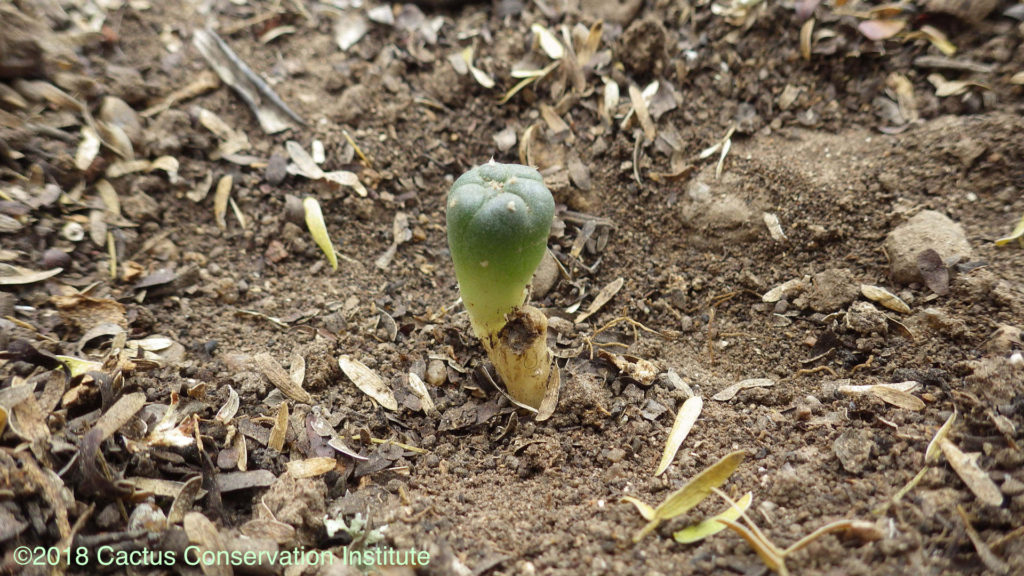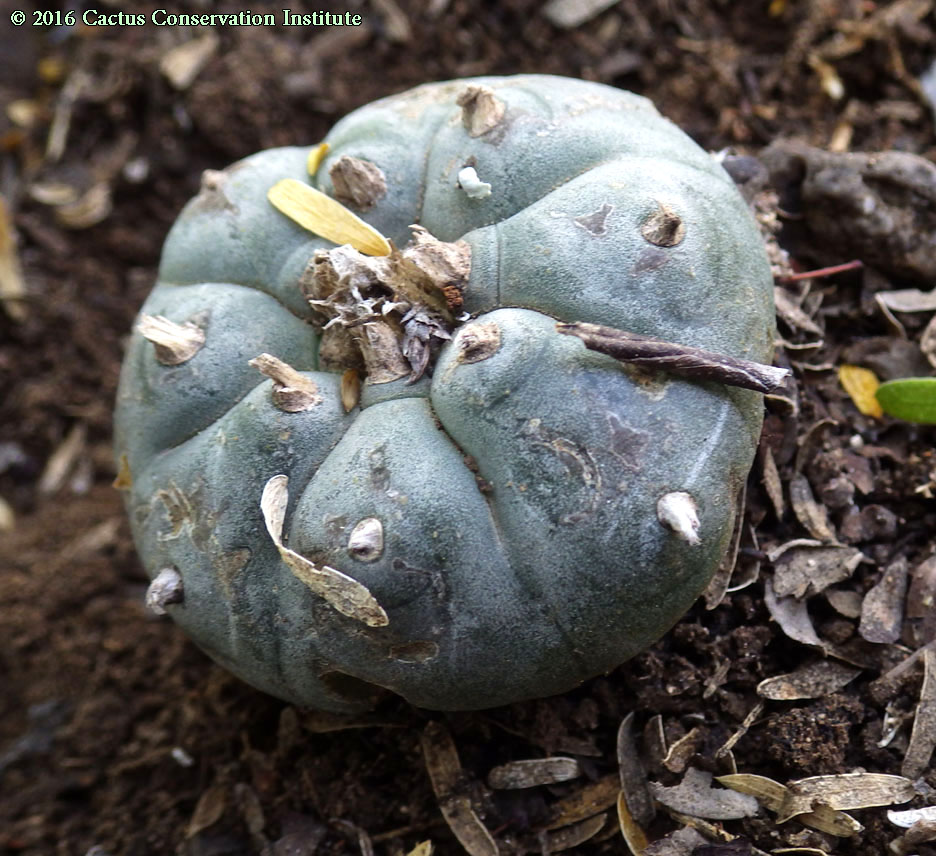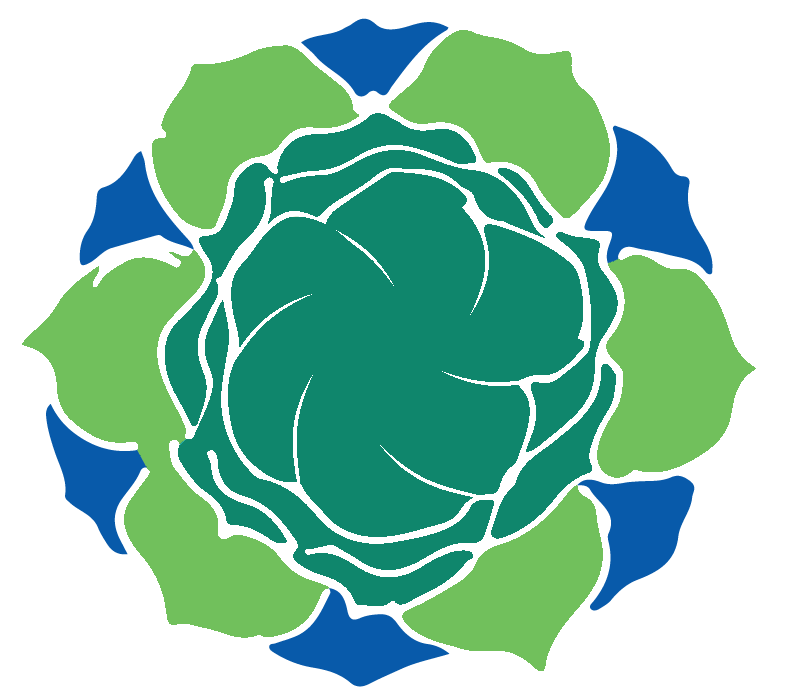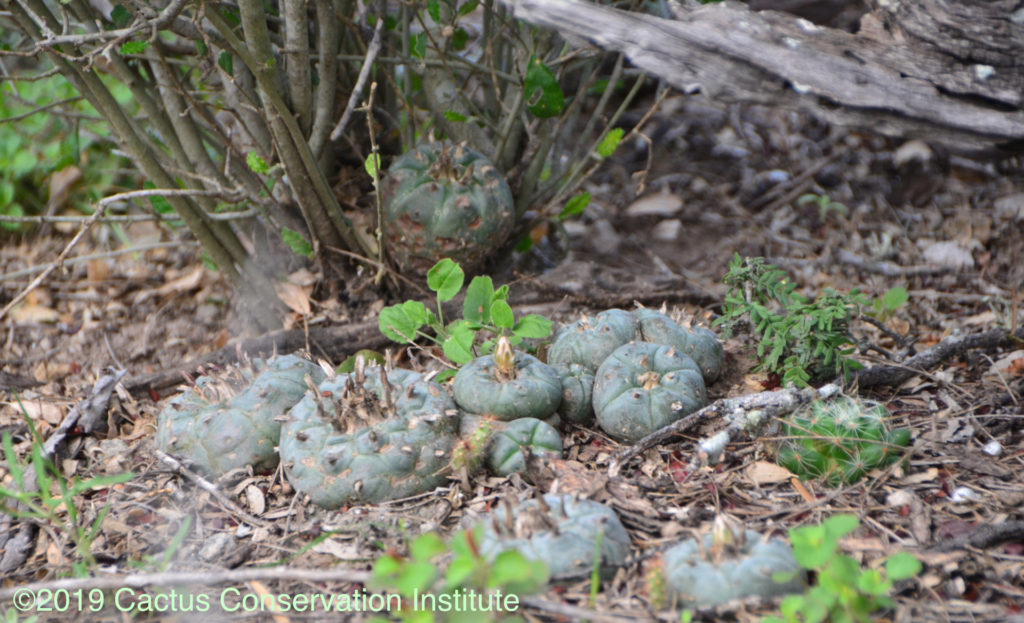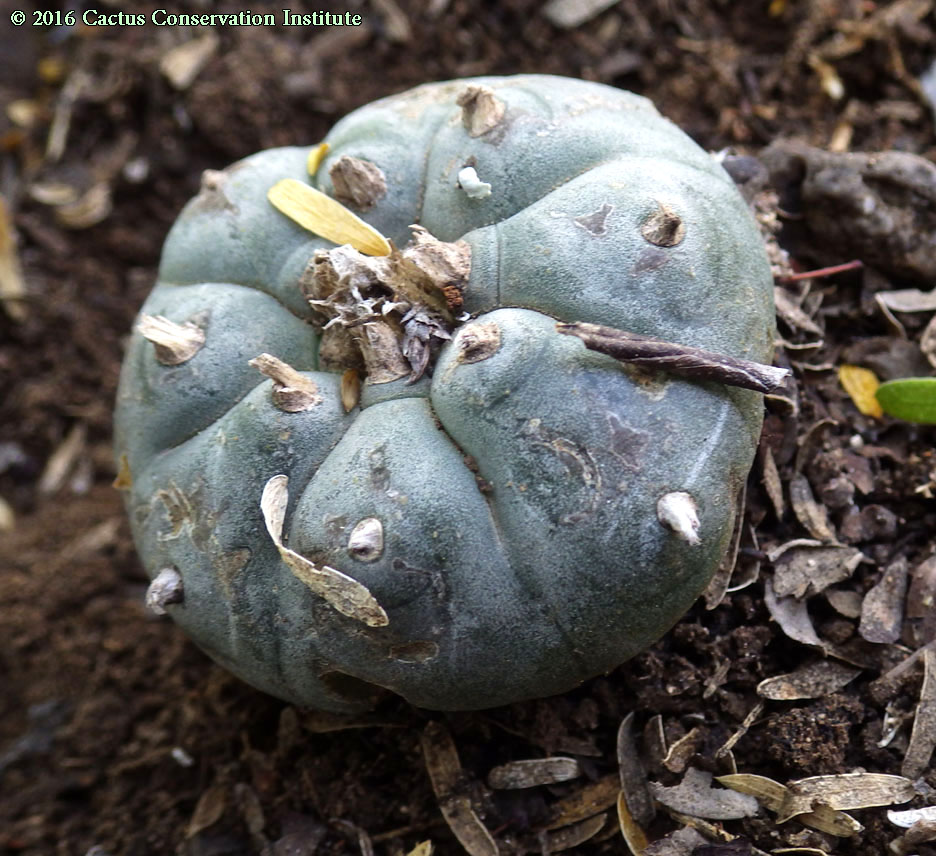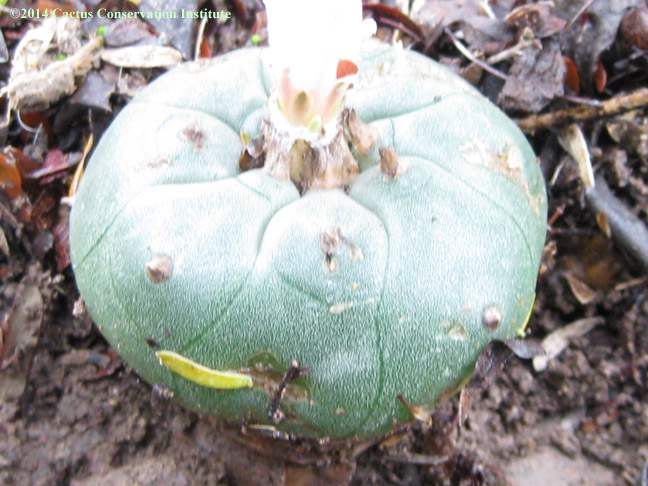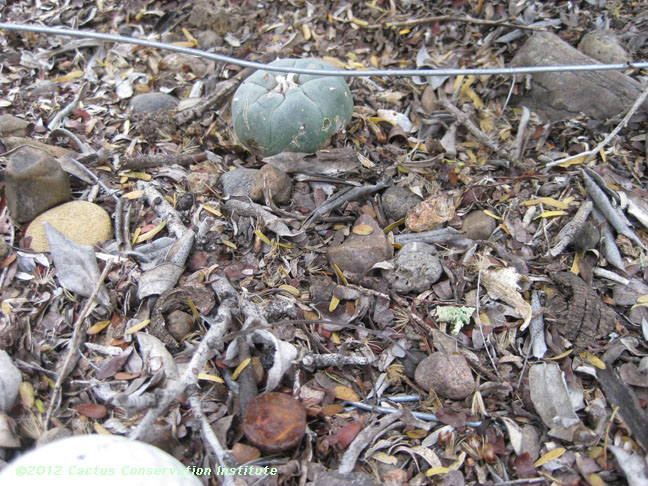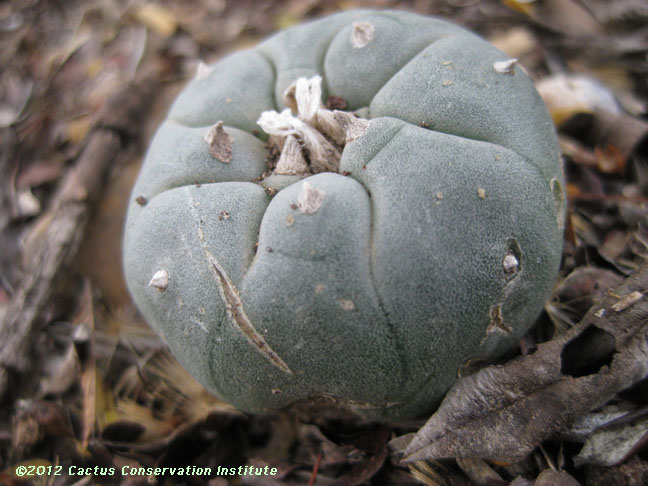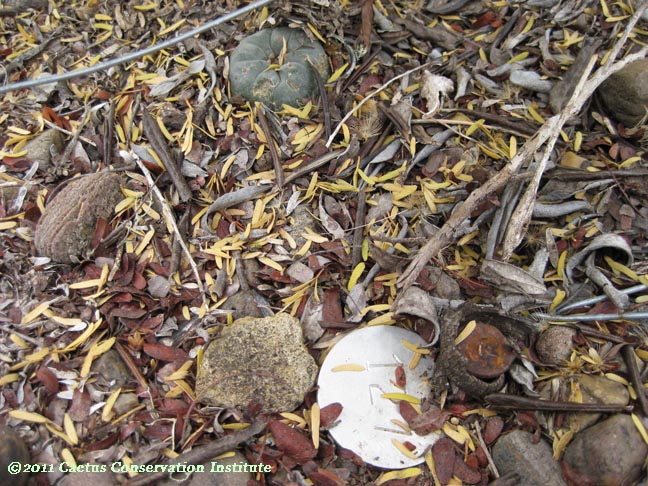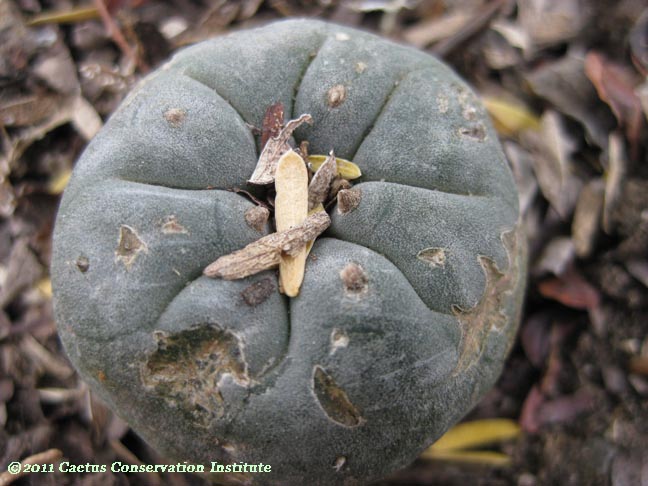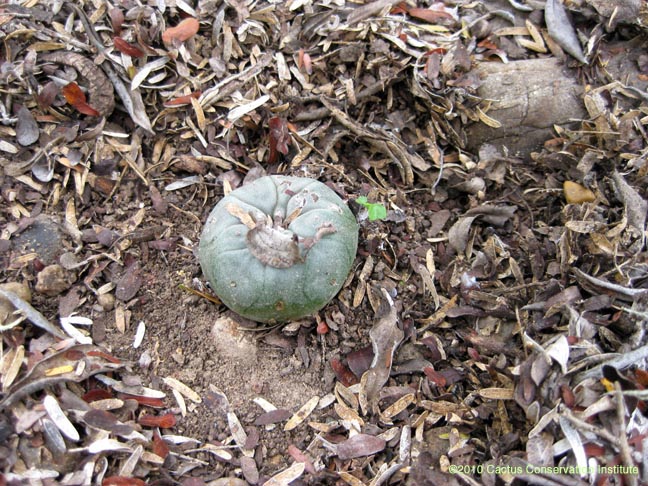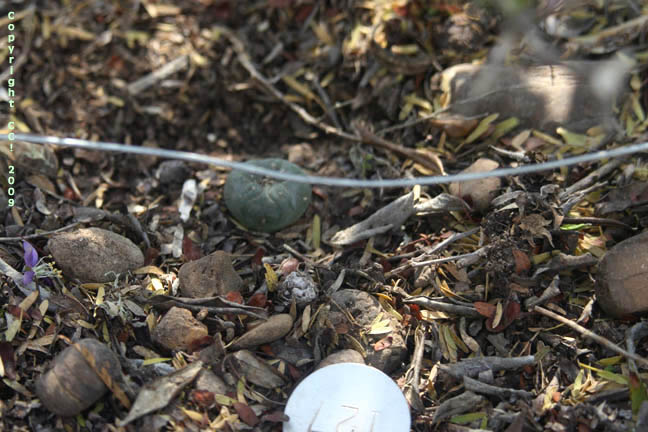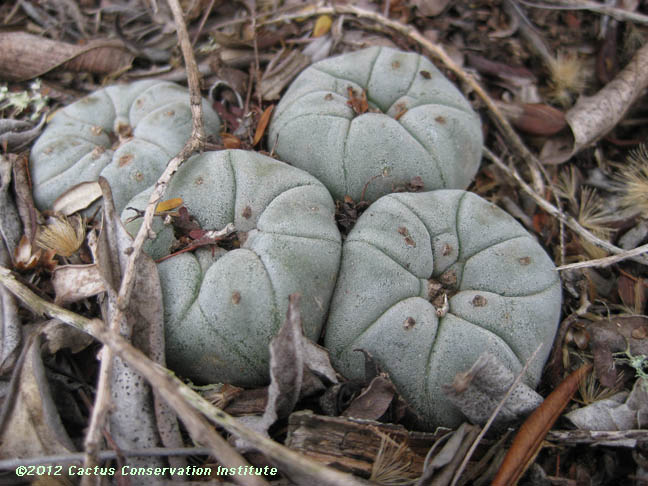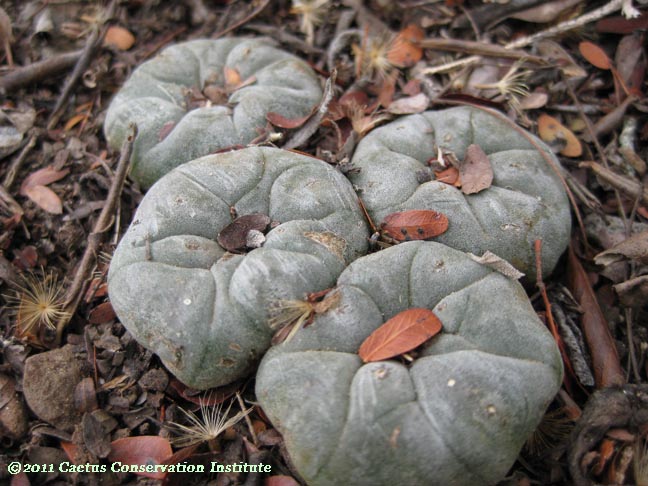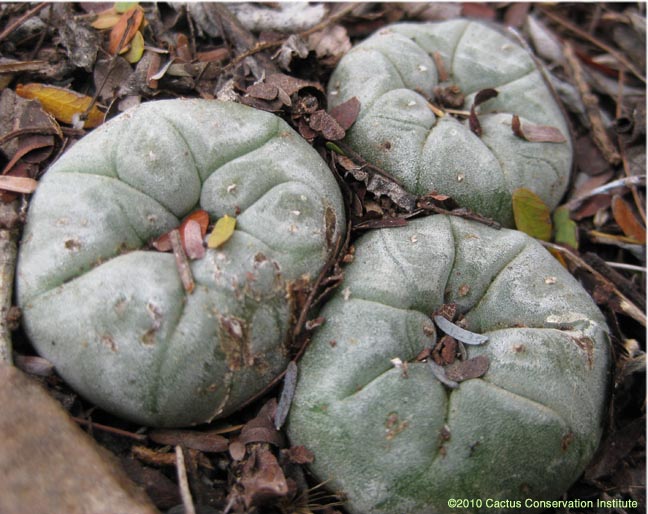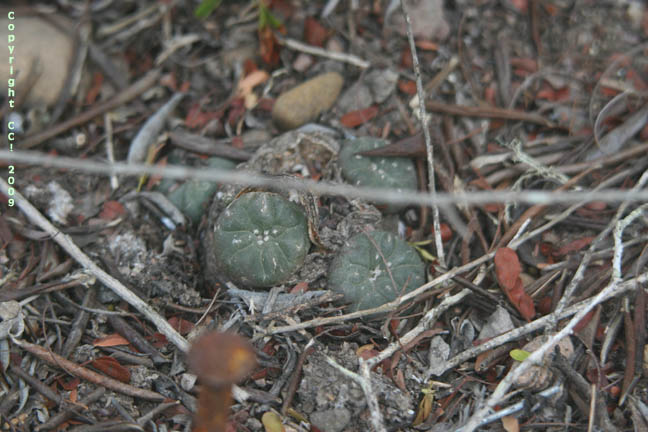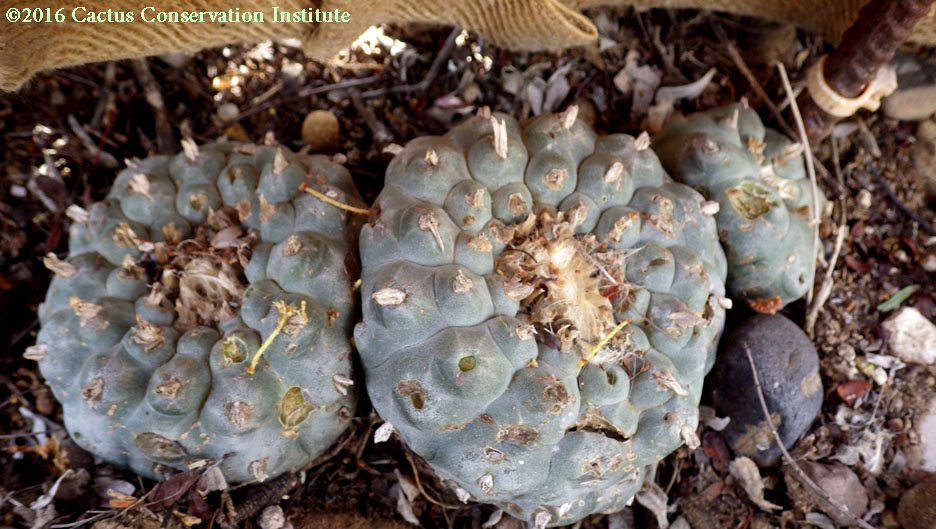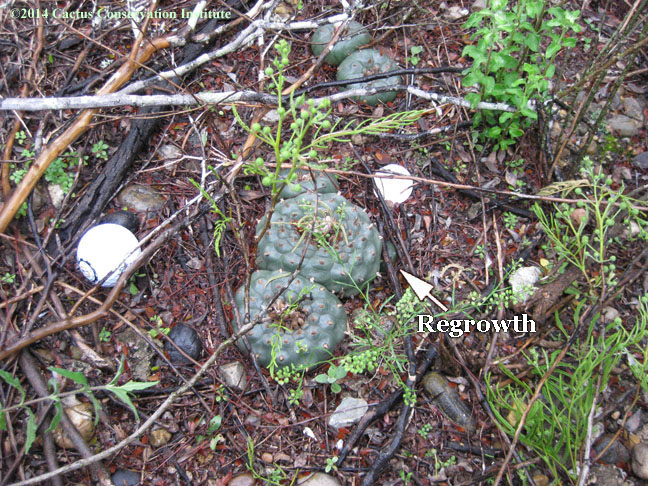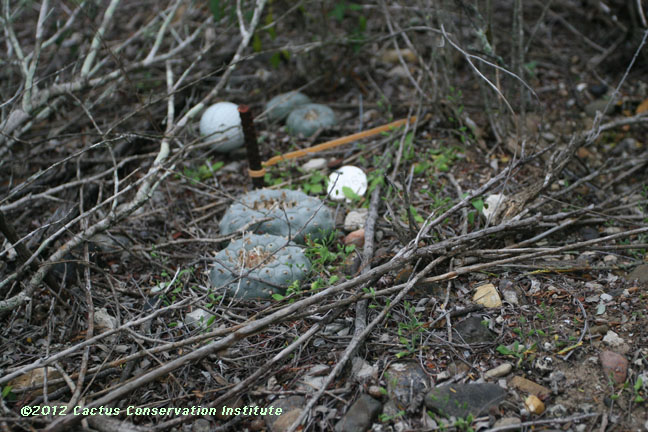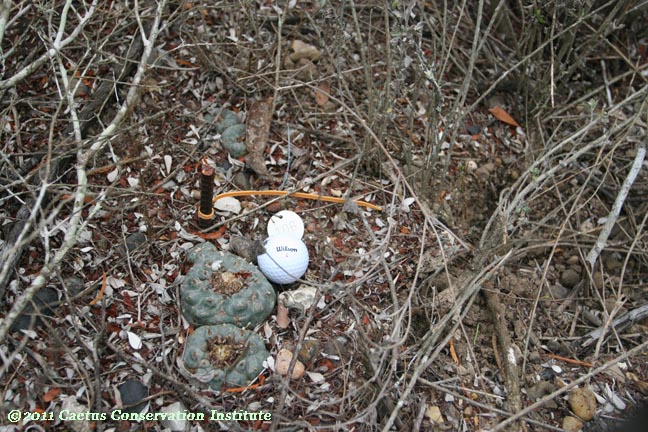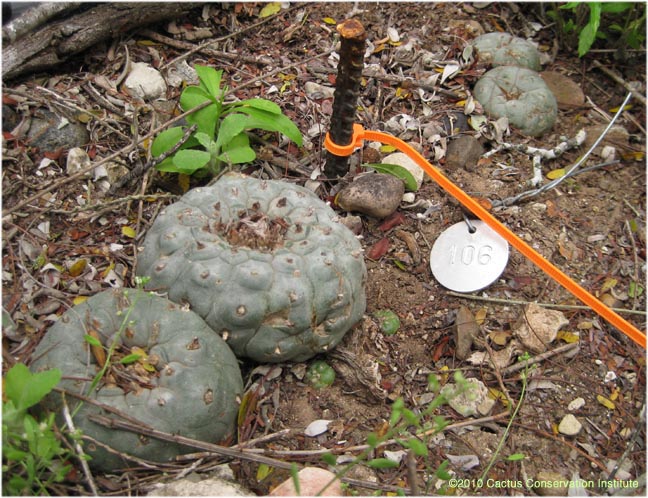2019 Update.
17 May 2019; summary by Keeper Trout, Anya Ermakova & Martin Terry.
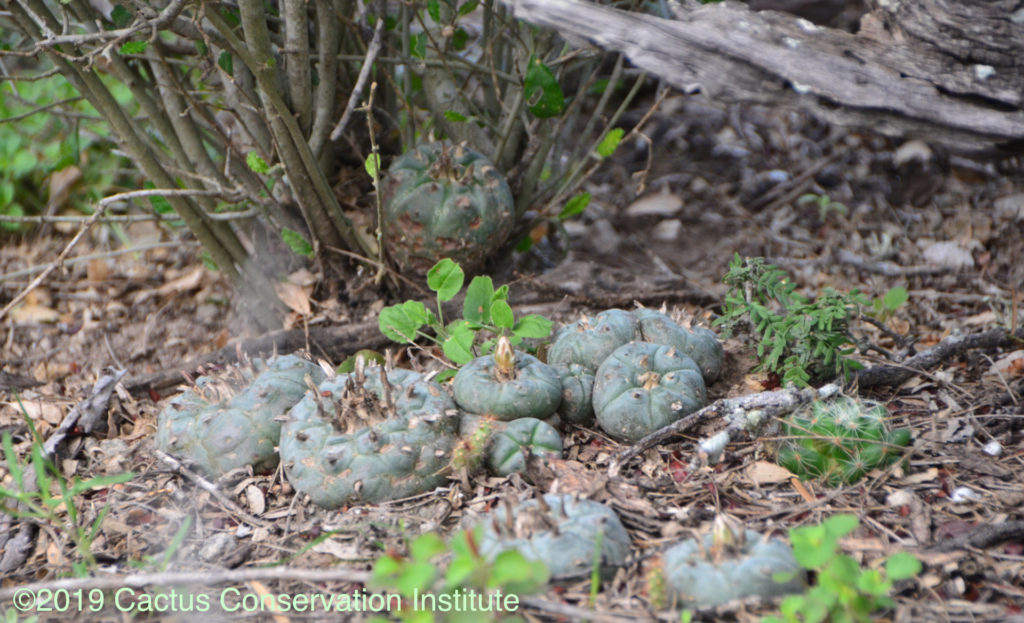
The last two visits to the study group (15 March 2018 and 1, 2 & 4 May 2019) have provided us with an unexpected opportunity to study the effects of harvesting even further than we had planned.
CCI’s original goal was to perform a four-year study on mortality and survival rates following a legal peyote harvesting event, occurring on 3 March 2008 using the best known practices. Even before we had completed that 4-yr study and published the results (see 2011 & 2012), we decided to continue to monitor the population for a longer period of time; dropping the frequency of our visits to every 2 years. One additional element involved evaluating the effect of harvesting performed on a two-year schedule similar to what we had been informed was then being done by collectors working for the licensed distributors (see 2014). This was done using a very limited number of plants due to our concerns that it would show increased mortality rates. It did of course but we were also amazed by the incredible resilience of the plants. We were however thinking that our 10-yr visit in 2018 might be our last visit as we felt that we had pulled as much data as we possibly could out of so few individuals.
Fate provided the unexpected opportunity that was referred to earlier. When we reached the site in 2018, we soon discovered that the entire first section of our research group, which included all of the re-harvested individuals, had been largely harvested by poachers or at least was only partially intact. Since our area of interest was studying the impact of harvesting, including plants harvested too frequently, being given a chance to directly examine such a harvest was an amazing windfall and we decided to continue our visits.
The chance of poaching occurring was certainly no surprise to any of us; we were, in fact, all rather pleasantly surprised that it had taken so many years to finally happen.
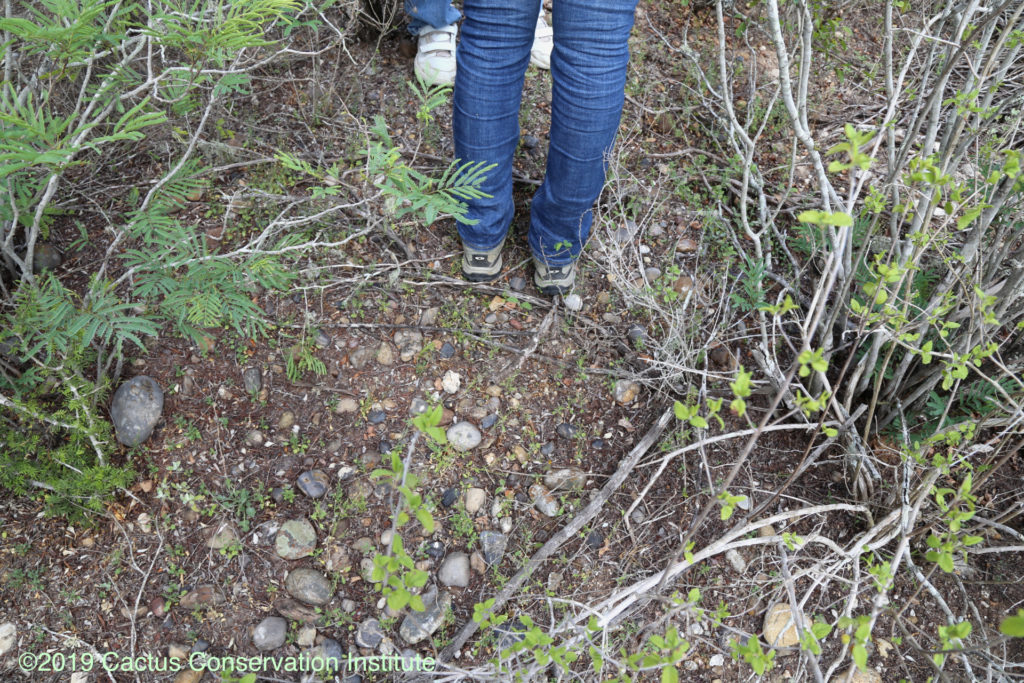
Our original hope was to be able to study commercial harvesting practices by following behind their collectors but we were unable to find anyone who was interested in our doing so. Instead, Blake was fortunate enough to meet Teodoso Herrera, a spiritual leader of one of the original indigenous peyote people of South Texas (the Tāp Pīlam Coahuiltecan Nation; which is recognized by the state of Texas but, sadly, not by the federal government). After discussing the benefits of this knowledge to both peyote and peyote people and obtaining his support, we were granted access to the population that Ted used for fulfilling his own small group’s Medicine requirements.
An area where he did not harvest was selected by Ted and, with permission both from him and from the land owner, it became the site chosen for this study.
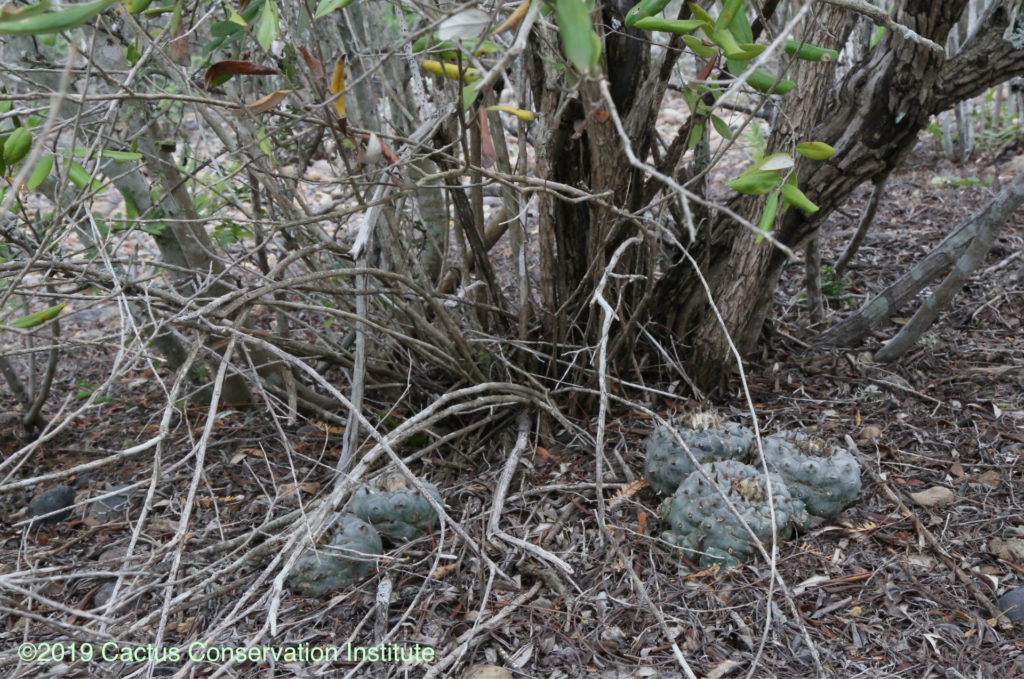
One significant element affecting peyote survival is harvesting, especially poaching, so the harvesting was an interesting bit of serendipity. It might on the surface seem like poaching and harvesting involve the same physical operation. The mechanics are the same but poachers are more likely to be in a hurry AND are more likely to be unaware of the date the field was last visited by harvesters. Repeated harvests can and do easily occur with no knowledge as to the dates of previous harvests on that same parcel; this can be true even for a person harvesting under a lease agreement. The harvester can only gauge appropriate choices based on size and condition of what is visible. The size of a crown at the surface may not necessarily reflect the compromised state of its underground parts if those have been repeatedly harvested toward exhaustion. This is due to harvesting removing the ability of the plant to photosynthesize and requiring it to rely on the resources stored in the underground stem until new green tissue can be produced. Repeated harvests that are too close together result in diminished regrowth as will be seen in the images that follow.
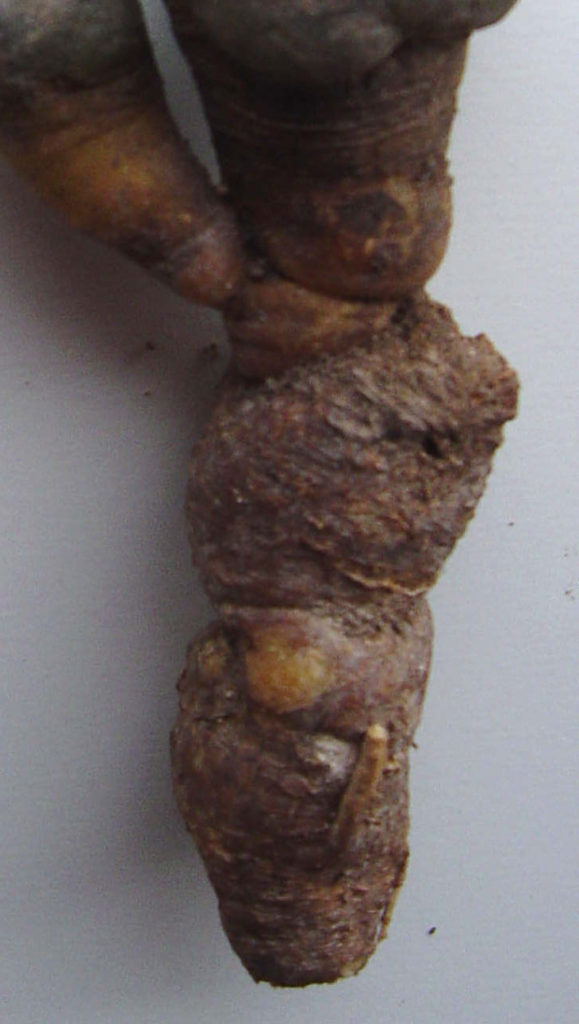
The single most fortuitous element was the fact that we had records of not just where the plants in the study group were located. They also included how often they had been harvested and the date(s) of any time or times of being harvested during the previous decade of study. (The original individuals were chosen on the basis of never having been harvested.)
While our efforts had attempted to minimize our impact on plants other than those seeing harvest, this unplanned harvesting by poachers provided a real-world look at the impact of a typical Tragedy-of-the-Commons peyote harvest. The harvesters did not simply harvest a few plants at the beginning of the study, they also removed almost all of the former abundance of peyote plants for some yards on either side of them leaving only a handful of plants. In doing so they also removed surprising amounts of the brush cover that protected the population, creating a few short trails that are clearly visible even from a satellite view.
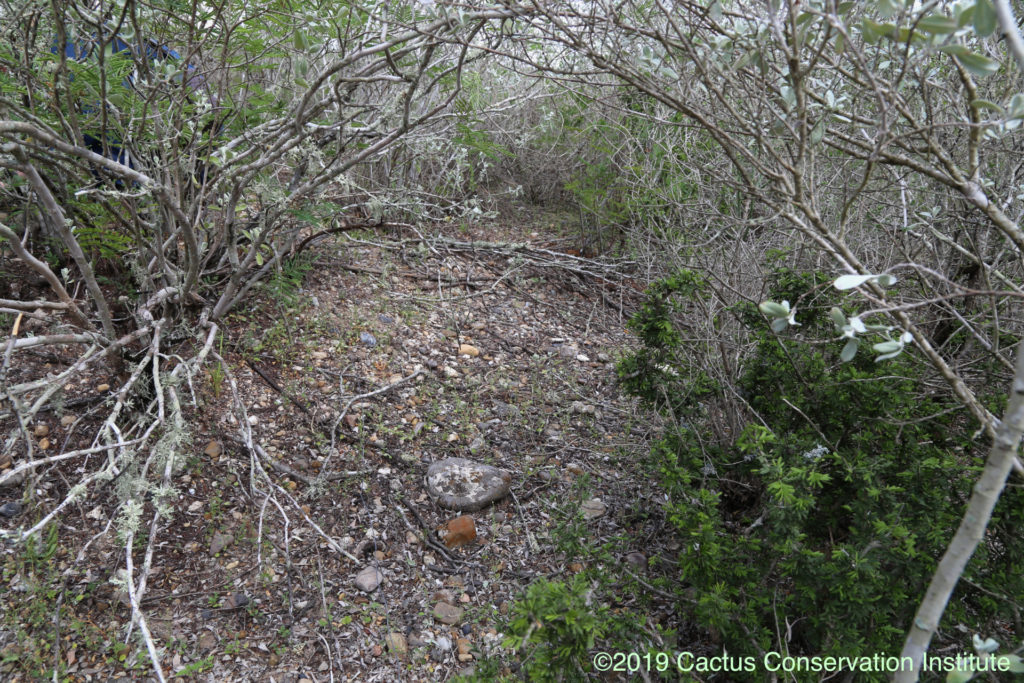
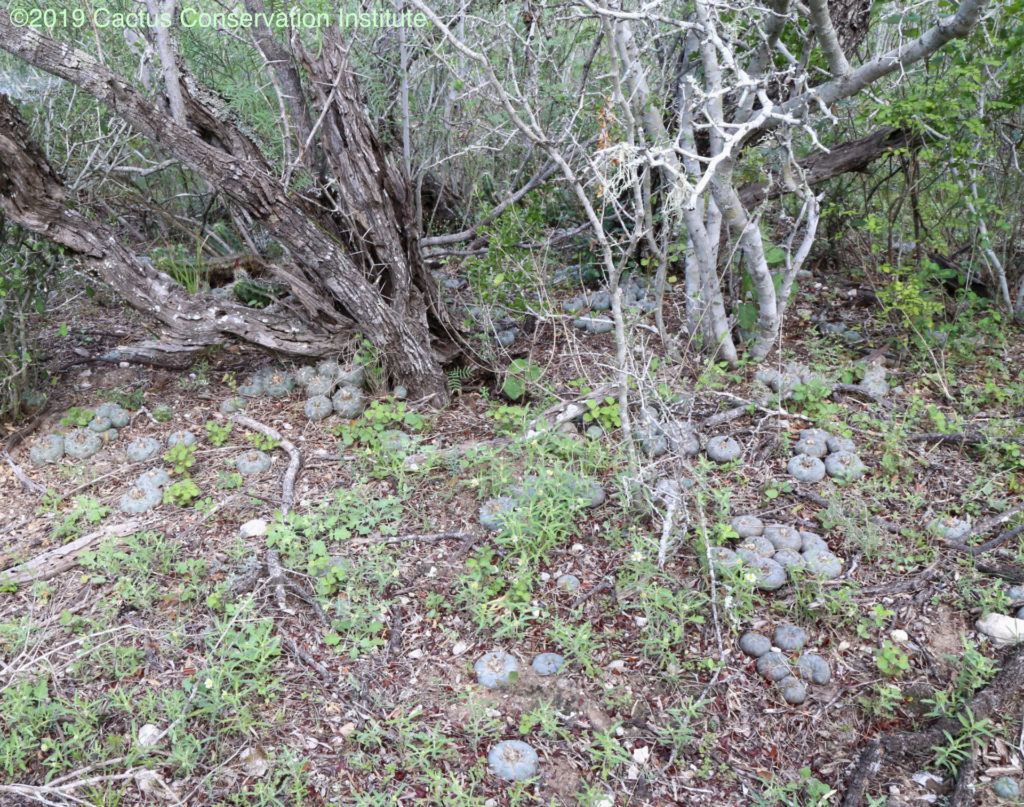
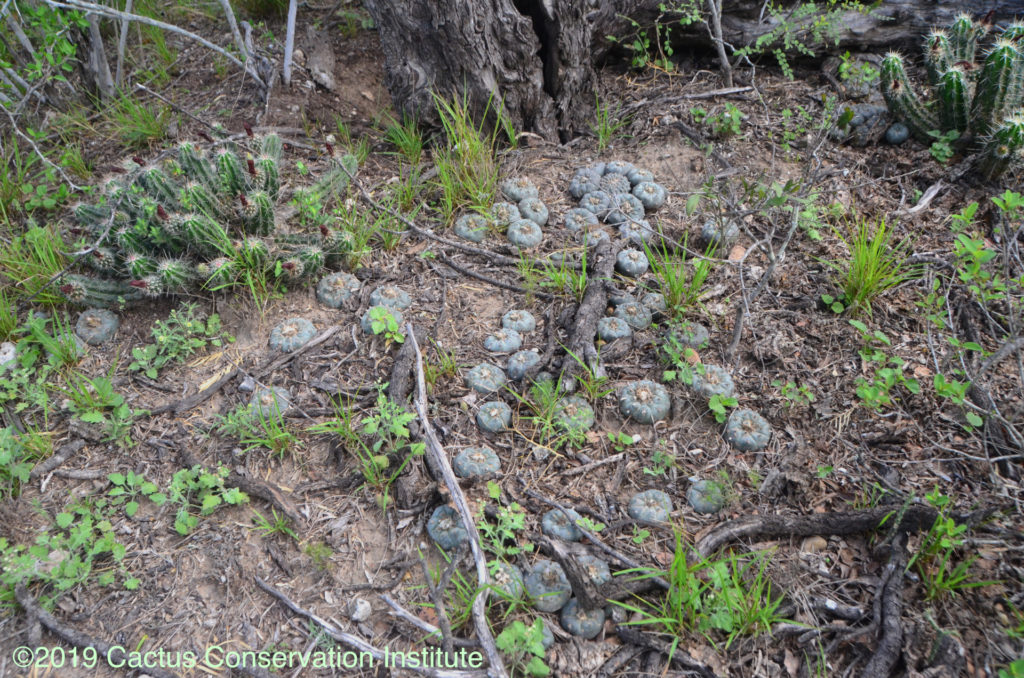
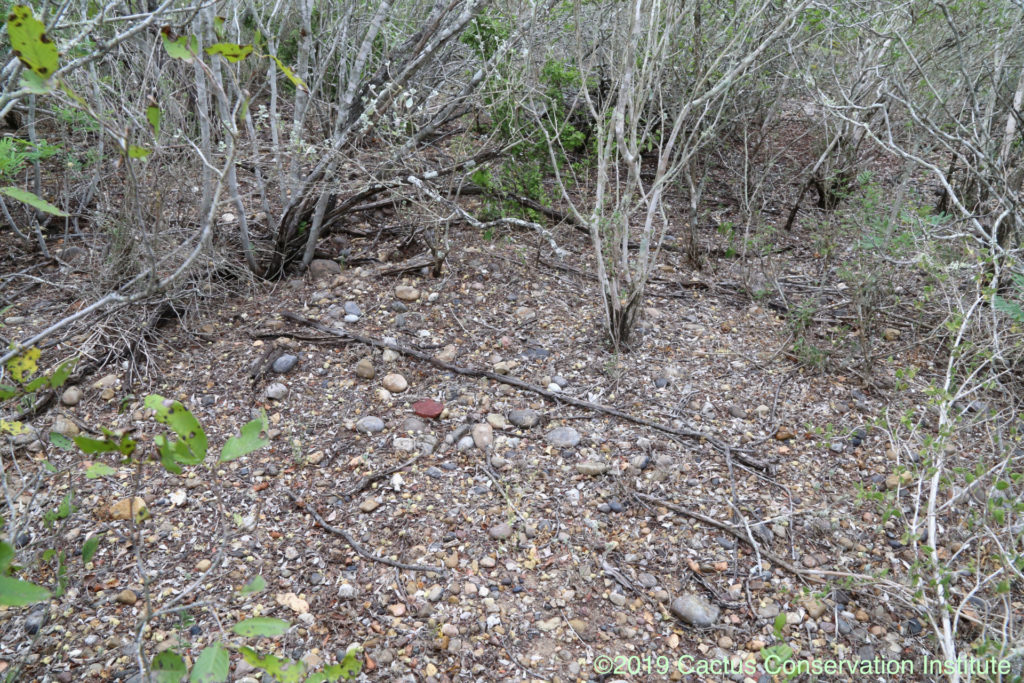
That last image showed the site of some peyote plants that were growing adjacent to the study group. It is obviously difficult to visualize plants that are not present, so a couple of pictures of those former residents are below.
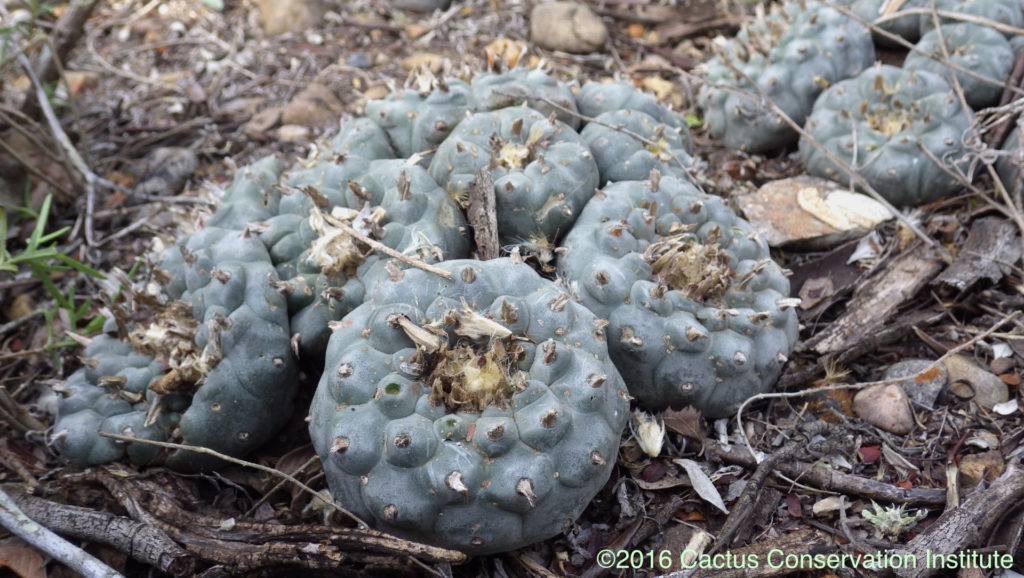
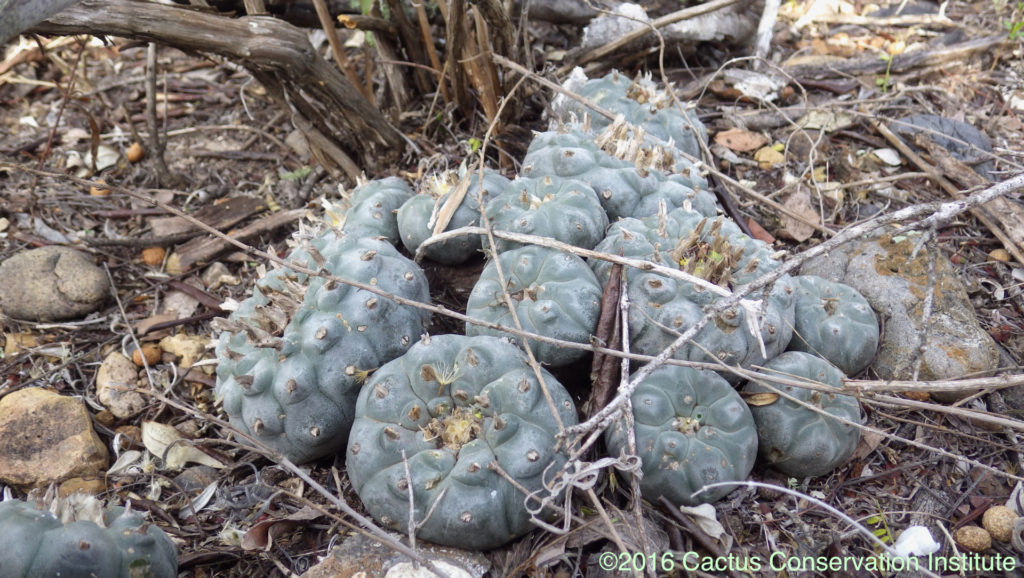
It has been 2 or so years now since the first of the harvests done by poachers occurred. With the exception of one intact plant (#103), we were unable to find any sign of life on any members of the study group until some distance farther into the brush. We also found only occasional individual plants outside of the study group had been missed in that entire area and did not see any apparent regrowth.
The sizes of stems and regrowth that we found on #127 indicated that it had experienced two harvests in between our visits in March 2016 and March 2018.
When it was first harvested in March 2008, it had a single 8-ribbed crown (4.3 cm in diameter) that weighed 28 grams.
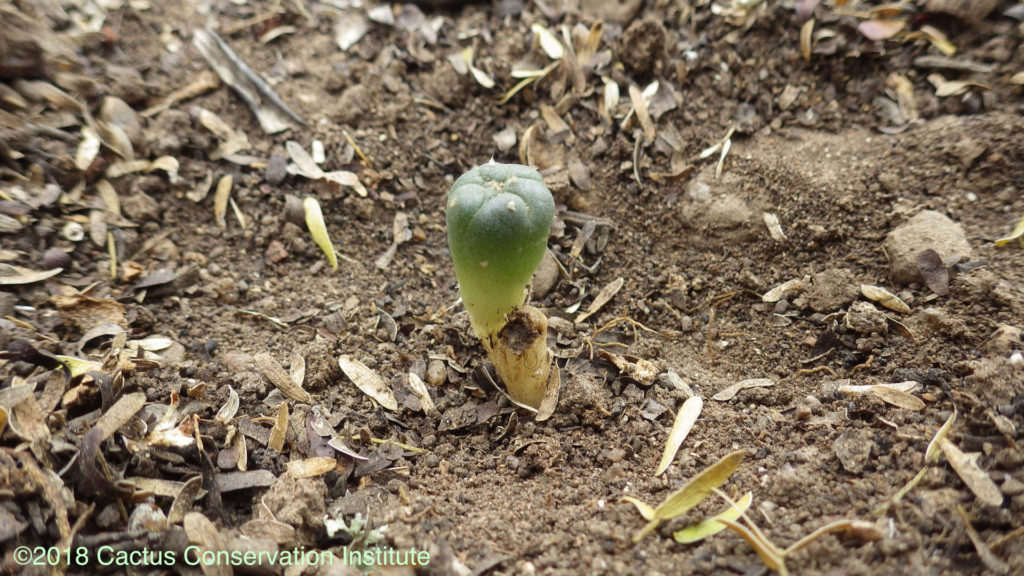

#127 in 2016

#127 in 2014 
#127 in 2012
Earlier views of #127

#127 in 2012

#127 in 2011 
#127 in 2011

#127 in 2010 
#127 in 2009
Specimen #129 nicely illustrates the adverse impact of repeated harvesting on the ability of the stem to produce new regrowth.
When #129 was first harvested in March 2008, it had a single 10-ribbed crown (5.3 cm in diameter) that weighed 34 grams.
Following that first harvest, four new crowns had appeared within the first eight months although no photographic record exists for that visit in November 2008. They can however clearly be seen in the image from March 2009 farther below.
It is very easy to see the effect of that most recent harvest by comparing the 2019 images to those of the original regrowth during 2009–2016.
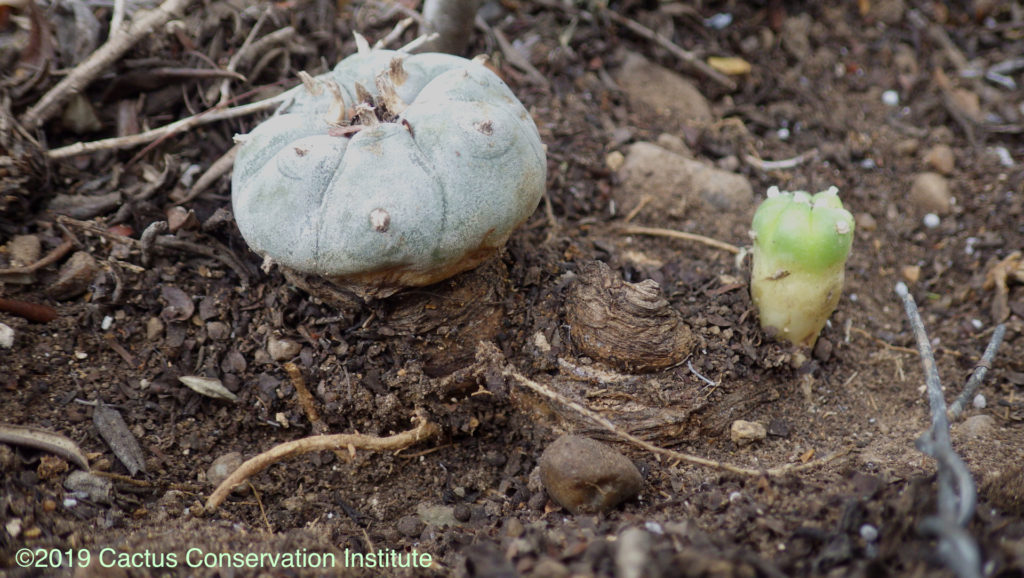
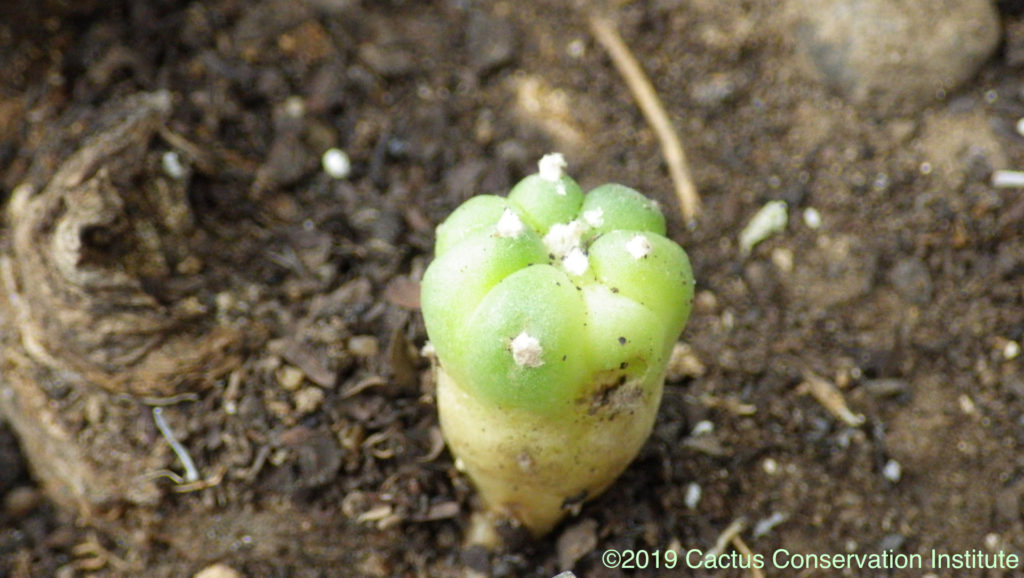
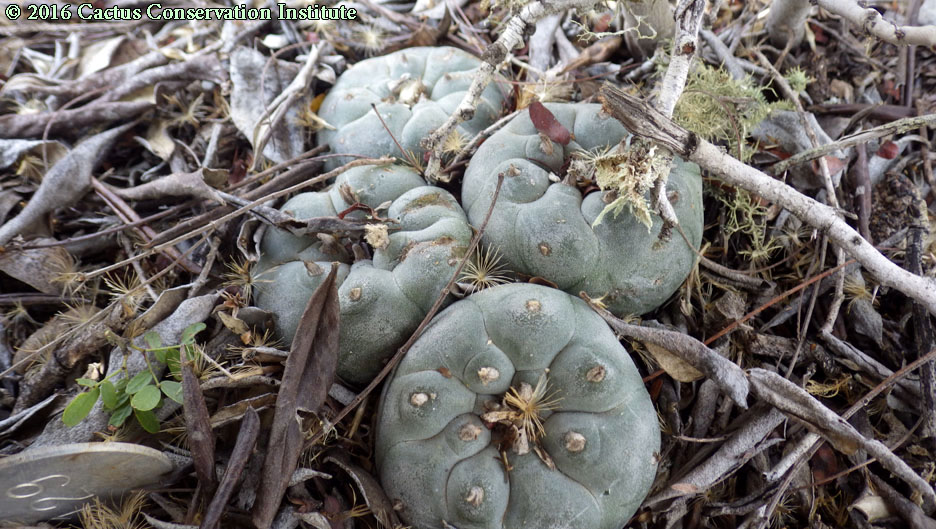
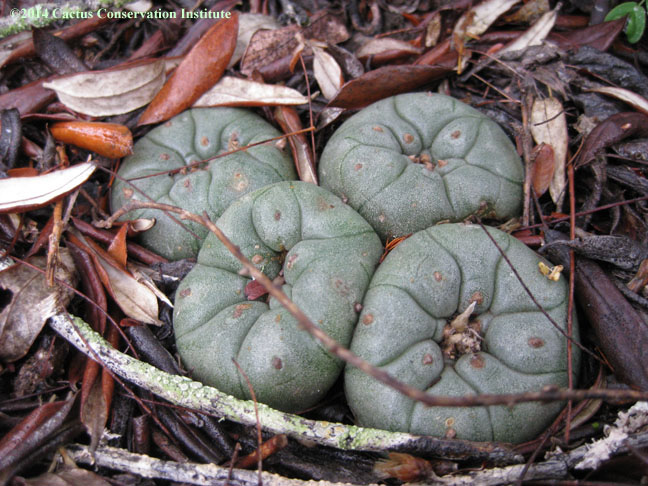

#129 in 2012 
#129 in 2011 
#129 in 2010 
#129 in 2009; showing one year of regrowth after a single harvest
At least one harvest of a plant with large crowns (#106) included the roots. (If this was a common practice employed by the poachers, it might help to explain what appears to a poor recovery of the plants that were not in the study group.)
Only a desiccating crown from a smaller plant that had been nearby was still detectable at the site of #106 in March 2018.
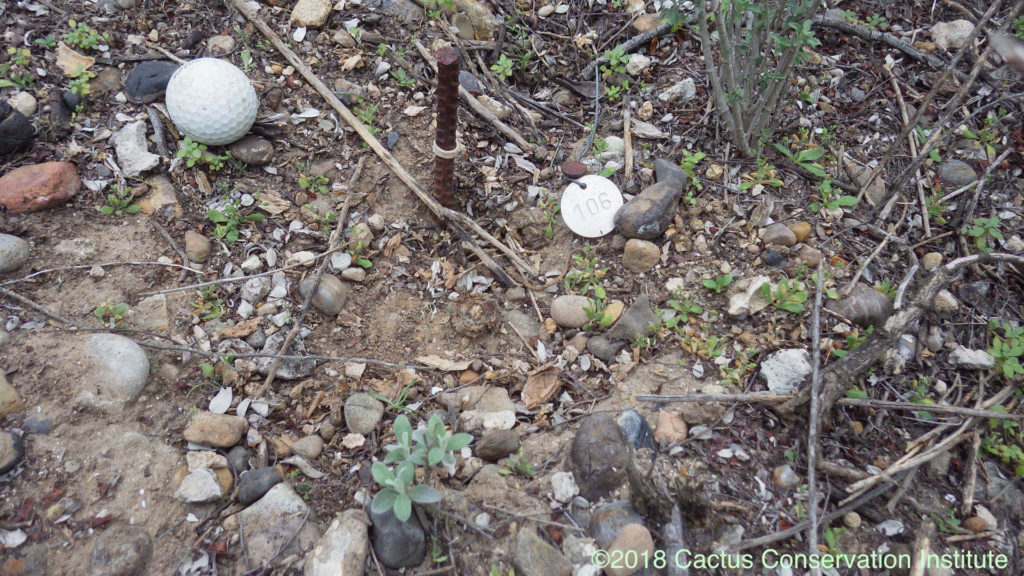
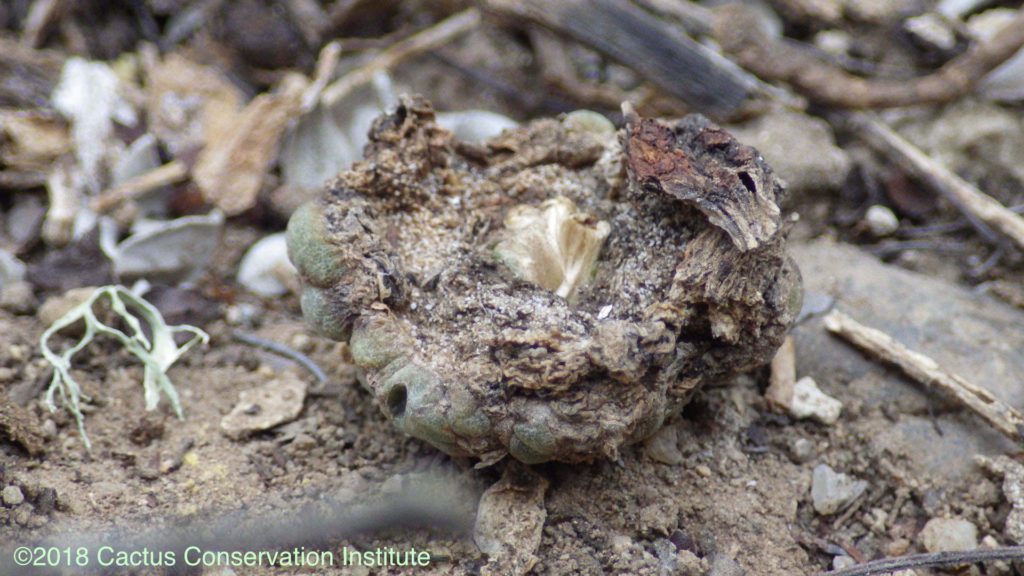
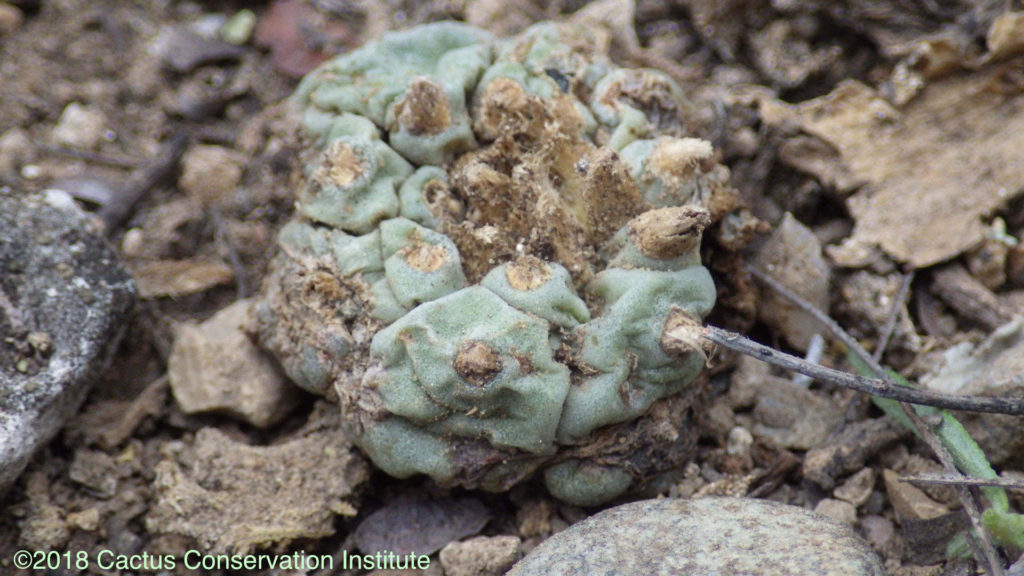
In May of 2019, all that still remained was a bit of peyote stem bark that was discovered when digging to locate a root or a carcass. These can persist in soil for up to several years before decomposing.
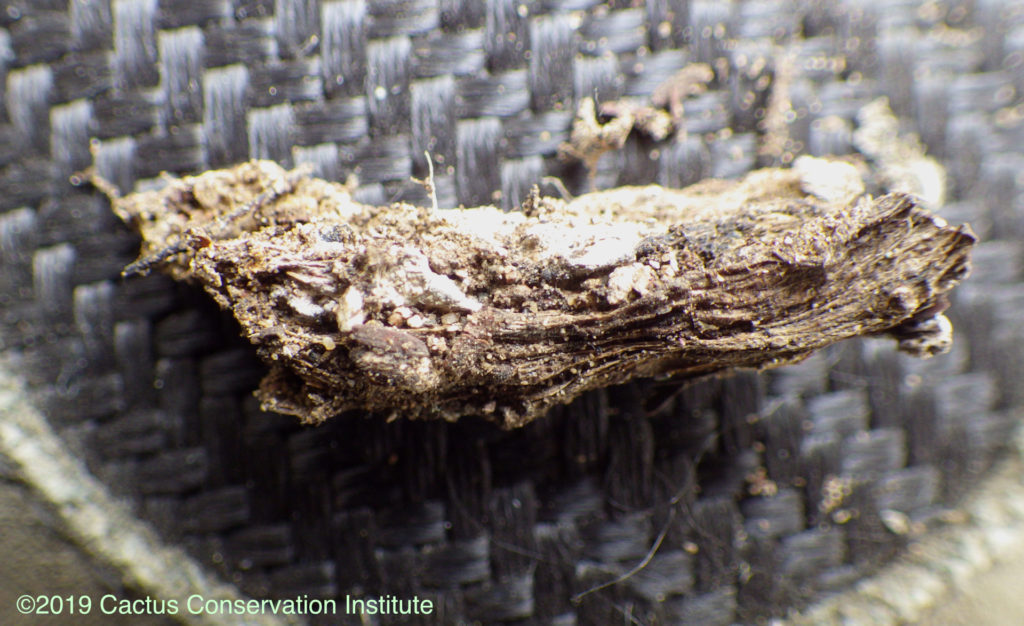

#106 in 2016 
#106 in 2014

#106 in 2012 
#106 in 2011

#106 in 2010
The next image is what healthy peyote populations can look like if given the right location and a chance. It is easy to appreciate why this part of Texas has been referred to as the Peyote Gardens.
It is perfectly reasonable to believe that good management practices and fully-informed, conscious harvesting could enable this resource to continue to exist for future generations.
The common harvesting practices that are presently at play (the broad acceptance of poached plants, harvesting through trespassing, harvesting small plants, harvesting so many plants as to compromise local seed production, and harvesting individuals too frequently) will continue to work against that being a possibility.
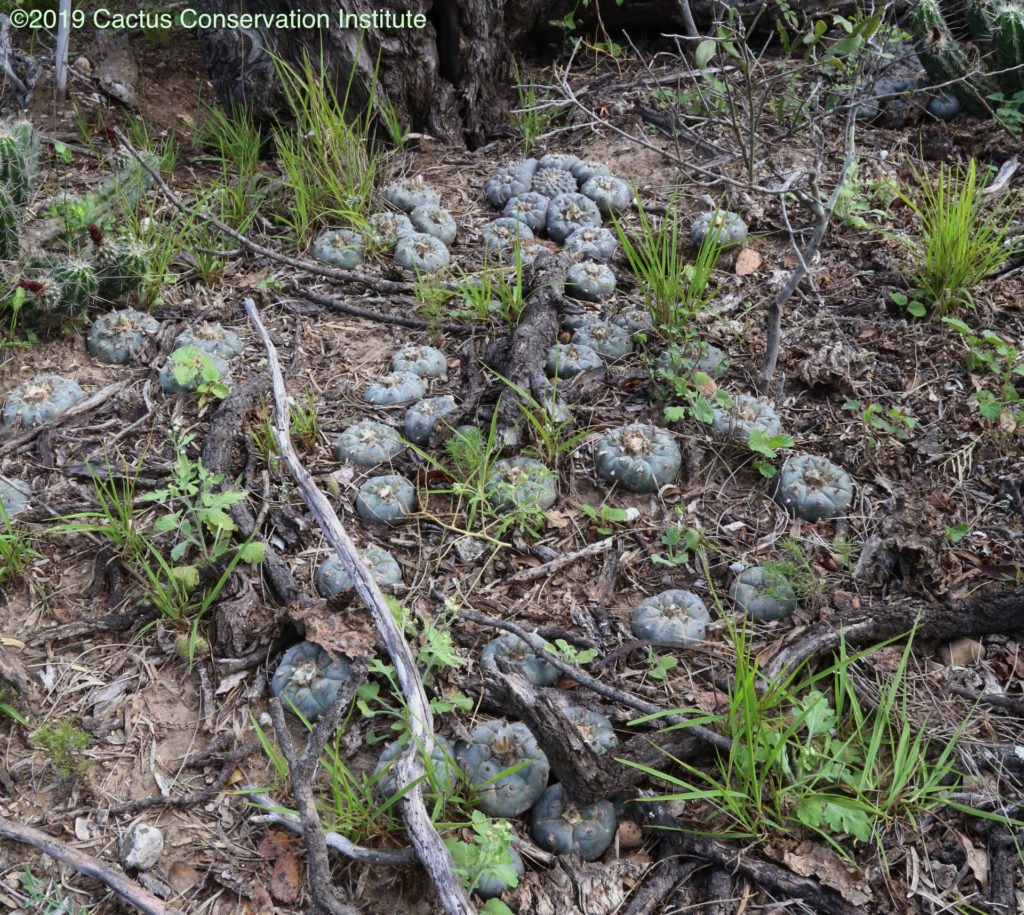
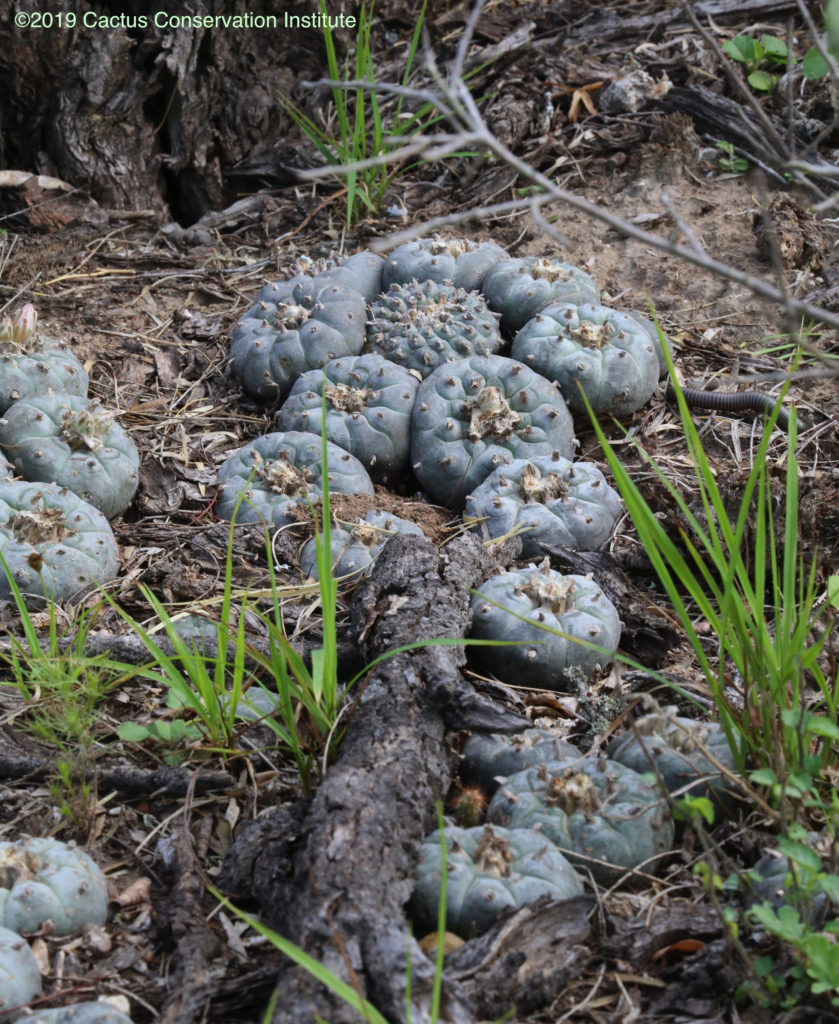
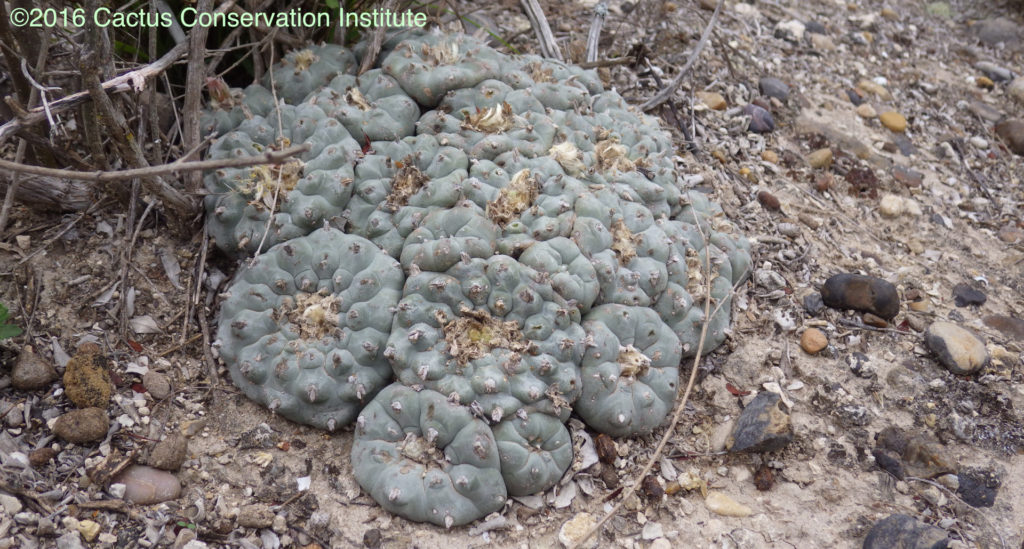
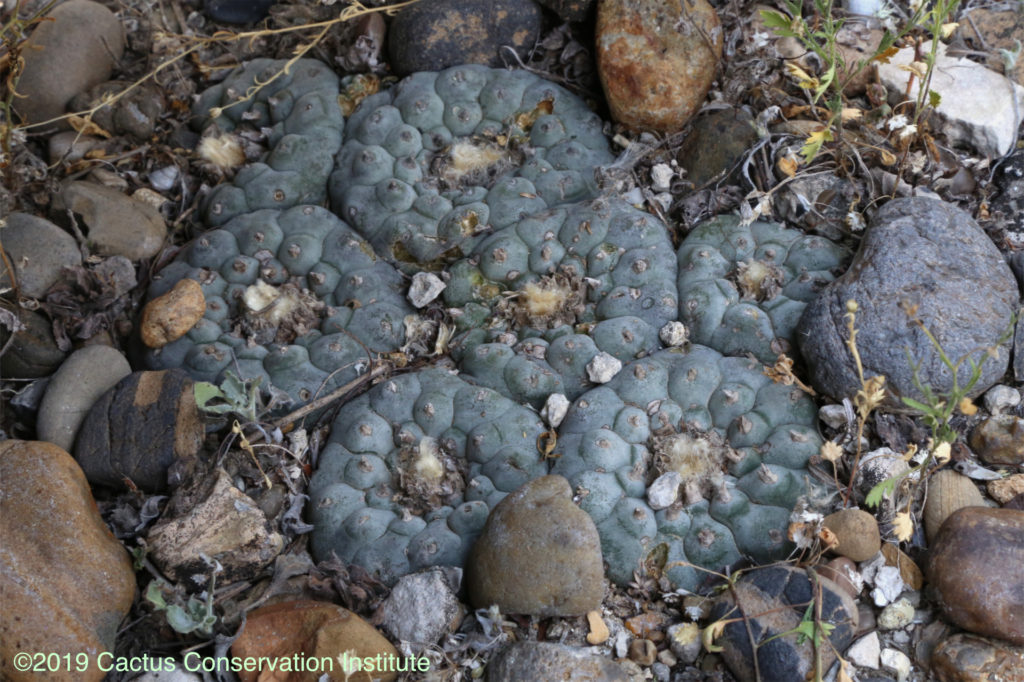
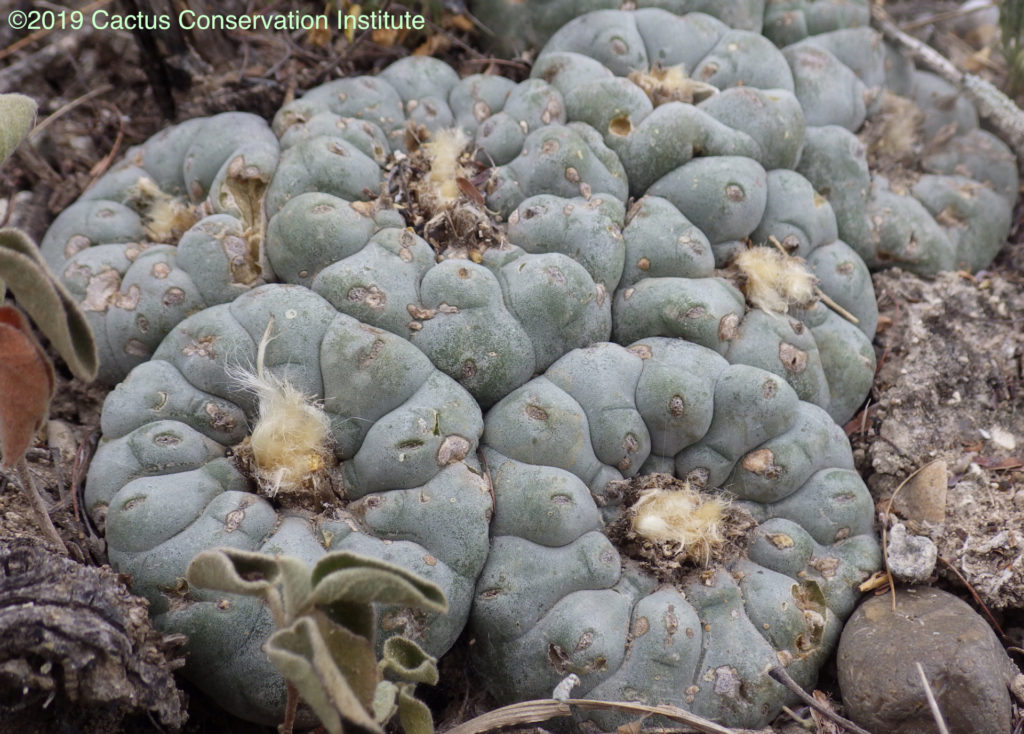
Additional reading online:
A look at peyote harvesting & the peyote trade.
A closer look at peyote growing in the wild can be found in an article at Erowid.
The Peyote Crisis & some Suggestions. Revisited. 2014
Related PDFs of potential interest:
Kevin Feeney. 2017. Peyote as Commodity: An Examination of Market Actors and Access Mechanisms. Human Organization 76(1): 59–72. [1.5 mb PDF]
Garrett Hardin 1968. The Tragedy of the Commons. Science, 162(3859): 1243—1248. [free PDF at publisher]
M. Abul Kalam, Molly T. Klein, Diana Hulsey, Keeper Trout, Paul Daley & Martin Terry. 2013. A preliminary report of mescaline concentrations in small regrowth crowns vs. mature crowns of Lophophora williamsii (Cactaceae); cultural, economic, and conservation implications. Journal of the Botanical Research Institute of Texas, 7 (1): 435–440.
[~1.8 Mb PDF]
Molly T. Klein, M. Kalam, Keeper Trout, Norma Fowler & Martin Terry. 2015. Mescaline concentrations in three principal tissues of Lophophora williamsii (Cactaceae): Implications for sustainable harvesting practices. Haseltonia 20: 34–42. [~4 Mb PDF]
Peyote Sales. 1986–2016. Peyote sales reported to Texas DPS by the licensed distributors. [PDF]
Martin Terry & James D. Mauseth. 2006. Root-shoot anatomy and post-harvest vegetative clonal development in Lophophora williamsii (Cactaceae: Cactaeae): implications for conservation. Sida, 22: 565–592.
[~ 3.02 Mb PDF]
Martin Terry, Teodoso Herrera, Keeper Trout, Bennie Williams & Norma Fowler. 2011. Limitations to natural production of Lophophora williamsii (Cactaceae) I. Regrowth and survivorship two years post harvest in a South Texas population. Journal of the Botanical Research Institute of Texas, 5 (2): 661–675.
[~8.7 Mb PDF]
Martin Terry, Teodoso Herrera, Keeper Trout, Bennie Williams & Norma Fowler. 2012. Limitations to natural production of Lophophora williamsii (Cactaceae) II. Effects of repeated harvesting at two-year intervals in a South Texas population. Journal of the Botanical Research Institute of Texas, 6 (2): 567–577.
[~1.5 Mb PDF]
Martin Terry, Teodoso Herrera, Keeper Trout, Bennie Williams & Norma Fowler. 2014. Limitations to natural production of Lophophora williamsii (Cactaceae) III. Effects of repeated harvesting at two-year intervals for six years in a South Texas population. Journal of the Botanical Research Institute of Texas, 8 (2): 541–550.
[1.9 Mb PDF]
